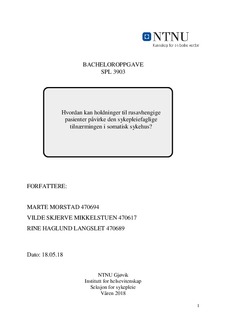| dc.contributor.advisor | Balke, Inger | |
| dc.contributor.author | Morstad, Marte | |
| dc.contributor.author | Mikkelstuen, Vilde Skjerve | |
| dc.contributor.author | Langslet, Rine Haglund | |
| dc.date.accessioned | 2018-08-30T09:09:55Z | |
| dc.date.available | 2018-08-30T09:09:55Z | |
| dc.date.issued | 2018 | |
| dc.identifier.uri | http://hdl.handle.net/11250/2560004 | |
| dc.description.abstract | Introduksjon: Mennesker med rusavhengighet har ofte en stor risiko for problemer knyttet til egen helse, og har derfor behov for behandling. Det anslås at det finnes mellom 8700 og 12 300 injiserende rusavhengige og mellom 66 500 og 123 000 mennesker med alkoholproblemer i Norge som har behov for medisinsk behandling. Rusavhengighet har i lang tid vært, og er fremdeles forbundet med negative holdninger og stigmatisering. Hensikt: Hensikten med denne litteraturstudien er å belyse hvilke konsekvenser sykepleiers holdninger til den rusavhengige pasienten kan ha for den sykepleiefaglige tilnærmingen. Metode: Oppgaven er en litteraturstudie, der forskningsbasert litteratur ble benyttet. Et systematisk søk etter vitenskapelige artikler i databasene CINAHL, Medline og Pubmed, ble gjennomført i tidsperioden mars - april 2018. Søkeord: stigma, attitude of health personnel, substance use disorder og nurse patient relations. Resultat: Funn som belyses ut ifra vitenskapelige artikler viser til generelt negative holdninger til rusavhengige pasienter, hos sykepleiere ved somatiske avdelinger. Resultatet viser blant annet til kunnskapsmangel hos sykepleiere, som en viktig faktor for svekkelse i den sykepleiefaglige tilnærmingen. Konklusjon: Sykepleiers manglende kunnskap vedrørende rusavhengige pasienter bidrar til å skape stigmatiserende holdninger til denne pasientgruppen, som igjen kan resultere i en svekket sykepleiefaglig tilnærming og behandling av pasienten. En ser viktigheten av å utvikle og forbedre sykepleiers kunnskap vedrørende rusavhengighet, for å kunne styrke den sykepleiefaglige tilnærmingen til pasienten. | nb_NO |
| dc.description.abstract | Introduction: People with drug addiction often have a high risk of developing health problems and therefore need treatment. It is estimated that there are between 8700 and 12 300 injecting addicts and between 66 500 and 123 000 people with alcohol problems in Norway who need medical treatment. Addiction problems have for a long time been associated with negative attitudes and there is still significant stigma surrounding addiction. Purpose: The purpose of this literature review is to illuminate the consequences nurses’ attitudes towards the addicted patient may have for the nursing approach. Method: The assignment is a research-based literature study. A systematic search for scientific articles in the CINAHL, Medline and Pubmed databases was conducted during the March-April 2018 period. Keywords: stigma, attitude of health personnel, substance use disorder and nurse-patient relations. Results: Findings identified from scientific articles refer to generally negative attitudes towards the addicted patients in nurses at medical wards. The results show that lack of knowledge among nurses is an important factor for weakening of the nursing approach. Conclusion: Lack of knowledge among nurses regarding drug addicts is a factor in creating stigmatizing attitudes towards this patient group, which in turn can result in a weakened nursing approach and treatment of the patient. This clearly shows the importance of developing and improving nurses’ knowledge of drug addiction in order to strengthen the nursing approach towards the patient. | nb_NO |
| dc.language.iso | nob | nb_NO |
| dc.subject | sykepleie | nb_NO |
| dc.subject | rusavhengighet | nb_NO |
| dc.subject | somatikk | nb_NO |
| dc.title | Hvordan kan holdninger til rusavhengige pasienter påvirke den sykepleiefaglige tilnærmingen i somatisk sykehus? | nb_NO |
| dc.title.alternative | How can attitudes towards addicted patients affect the nursing approach in hospitals? | nb_NO |
| dc.type | Bachelor thesis | nb_NO |
| dc.subject.nsi | VDP::Medical disciplines: 700::Health sciences: 800::Nursing science: 808 | nb_NO |
| dc.source.pagenumber | 45 | nb_NO |
